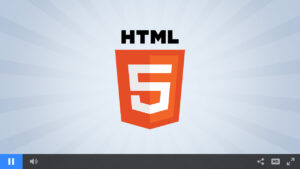Introduction
HTML5 has become the standard markup language for designing modern, interactive websites. With its extensive list of features and improved compatibility, HTML5 is an essential tool in every web developer’s toolkit. This ultimate guide will provide you with everything you need to know about HTML5, from its core elements to its best practices.
Table of Contents

What is HTML5?
HTML5 is the fifth and most recent version of the HyperText Markup Language (HTML). It was released in 2014 and has since been widely adopted by web developers and browsers alike. HTML5 was designed to improve the language’s performance, better support multimedia elements, and provide a more consistent user experience across various devices.
New Semantic Elements in HTML5
HTML5 introduced several new semantic elements that help structure the content on a web page more meaningfully. These elements include:
<article>: Represents a self-contained piece of content, like a blog post or news article.<aside>: Denotes content tangentially related to the main content, such as a sidebar or supplementary information.<details>: Provides additional information or context that can be shown or hidden by the user.<figcaption>: Represents a caption or description for a<figure>element.<figure>: Specifies an image, diagram, or other media that is referenced in the main content.<footer>: Indicates the footer section of a page, which typically contains copyright information, contact details, or other metadata.<header>: Defines the header section of a page, which often includes a logo, navigation menu, or other branding elements.<nav>: Represents a navigation menu containing links to other pages or sections within the same document.<section>: Used to group related content into distinct sections, such as chapters, topics, or themes.
These new semantic elements improve the clarity of your HTML code, making it more readable and accessible to search engines, screen readers, and other user agents.

Multimedia Support
HTML5 offers enhanced multimedia support through new elements and attributes designed for audio and video playback. The <audio> and <video> elements allow for seamless embedding of multimedia content without the need for external plugins like Flash.
Example usage:
[html]
<video controls="controls" width=""300"" height=""150"">
<source src=""example-video.mp4"" type=""video/mp4"" />
Your browser does not support the video tag.</video> [/html]
Graphics and Animation
HTML5 introduced two powerful elements for graphics and animation: <canvas> and <svg>. The <canvas> element provides a dynamic, scriptable drawing area for 2D graphics, while the <svg> element allows for the creation of scalable vector graphics directly within your HTML code.
Example usage:
[html]
<canvas id=""myCanvas"" width=""200"" height=""100""> </canvas>
[/html]
Forms and Input Types
HTML5 brought various enhancements to web forms, such as new input types, attributes, and validation mechanisms. Some notable new input types include:
email: For email addressestel: For telephone numbersurl: For web URLsnumber: For numeric inputrange: For a range of numbersdate: For selecting dates
Example usage:
[html]
<input id=""email"" name=""email"" required="""" type=""email"" placeholder=""[email protected]"" />
[/html]

Geolocation API
The Geolocation API allows developers to access a user’s geographical location, enabling features like location-based search results and mapping services. This API is available through JavaScript and requires user consent before accessing their location data.
Example
[js]
if (navigator.geolocation) {
navigator.geolocation.getCurrentPosition(showPosition);
} else {
console.log("Geolocation is not supported by this browser.");
}
function showPosition(position) {
console.log("Latitude: " + position.coords.latitude + ", Longitude: " + position.coords.longitude);
}
[/js]
Local Storage
HTML5 introduced the Web Storage API, which provides a way to store key-value pairs in the user’s browser. This API consists of two objects: localStorage and sessionStorage. localStorage persists data across browser sessions, while sessionStorage stores data only for the duration of the current session.
Example usage:
[js]
// Set a value in localStorage
localStorage.setItem(‘name’, ‘John Doe’);
// Retrieve a value from localStorage
const name = localStorage.getItem(‘name’);
console.log(name);
// Remove a value from localStorage
localStorage.removeItem(‘name’);
[/js]
Best Practices for HTML5
When working with HTML5, keep the following best practices in mind:
- Use semantic elements whenever possible to improve the structure and readability of your code.
- Employ the
<!DOCTYPE html>declaration at the beginning of your document to ensure proper rendering in modern browsers. - Include the
<meta charset="UTF-8">tag within your<head>section to specify the character encoding. - Make sure your HTML code is well-formatted and indented to enhance readability.
- Use comments to explain complex sections of your code or provide context for other developers.
- Validate your HTML code using an online validator, such as the W3C Markup Validation Service, to identify and fix any issues.
Conclusion
HTML5 has revolutionised the way we build websites, providing a host of new features and improvements to enhance the user experience. By understanding the core concepts and best practices outlined in this guide, you’ll be well-equipped to create modern, accessible, and interactive web pages using HTML5. Embrace the power of HTML5 and elevate your web development skills to new heights.


